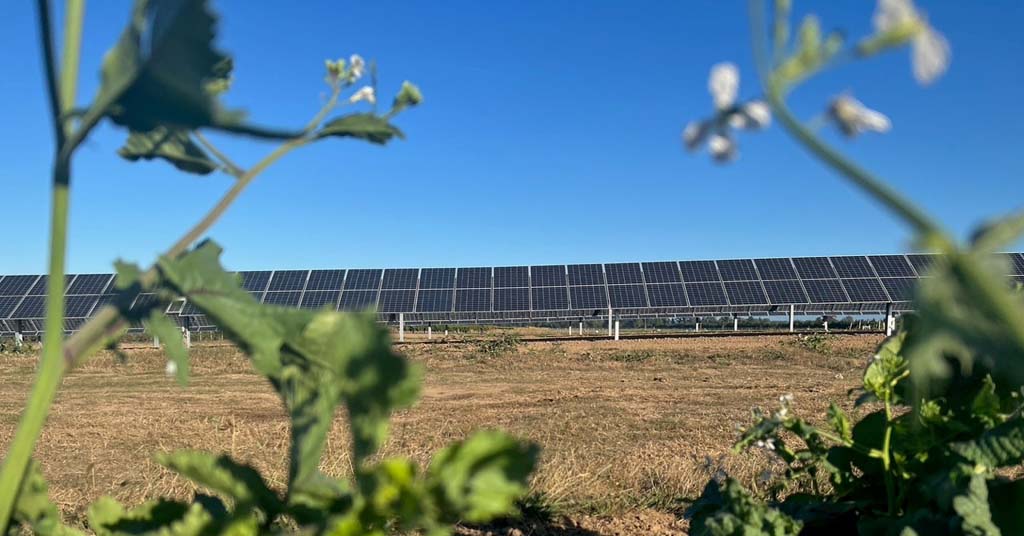Agrivoltaics integrates solar power and crop cultivation to the benefit of both. An OSU prof thinks it could be the future

Farm friendly? Agrivoltaics project at Oregon State University’s North Willamette Research and Extension Center in Aurora, Oregon. Photo: Dan Orzech
By Kendra Chamberlain. November 23, 2023. Solar energy and agriculture can play nice—in fact, solar panels might actually allow farmers to produce better crop yields.
It sounds counterintuitive, but that’s what Oregon State University Professor Chad Higgins is hoping to prove with a pilot agrivoltaics project in the Willamette Valley.
His project runs contrary to prevailing narratives in rural areas, where encroaching renewable energy facilities are seen as a threat to agriculture.
Higgins spoke about the project during a two-day conference held earlier this month in Corvallis by the nonprofit Sustainable Northwest.
“It’s not that the solar panels are impeding farm progress,” Higgins told the audience. “They are literally farming equipment that is used to manage a farm resource—light.”
Solar Harvest, the agrivoltaics collaboration between Oregon Clean Power Coop and OSU’s College of Agriculture, is the first field-scale research station aimed at studying whether solar panels can improve things like soil health, water use and crop yields.
It’s also part of a community solar program serving electricity to OSU’s North Willamette Research and Extension Center.
Solar Harvest just completed its first growing season after coming online in April.
Higgins said his group celebrated with a big harvest meal.
Throwing shade
Vast tracts of open land make agricultural areas a great place to place solar arrays.
But can large panels coexist with crops or livestock?

Sunny outlook: Chris Higgins. Photo: OSU
Higgins calls sunlight the “forgotten resource” on agricultural land.
“It’s the one that is least likely to be managed,” said Higgins, adding that sunlight is always in excess on a farm.
“It’s uncommon to realize how much energy is in sunlight. There’s so much energy in sunlight that the plants can’t take it all,” he said.
Placing solar panels on agricultural land can serve a dual purpose.
The panels generate energy that can be used by the farm—or delivered to residential homes.
Panels can also help plants and animals survive the hottest, driest parts of the year by providing shade. Shade can translate into reduced water demand.
“What is the plant to do when it gets too much energy? It heats up. What’s the only thing a plant can do to cool down? Drink water,” said Higgins. “So all of that excess solar that goes onto the plants is translated one-to-one to water draw from the ground—that goes into nothing productive. All you have to do is shade the plants and you save a proportional amount of water.”
Extra shade offers other benefits to the crops: cooler soils, increased humidity, less stress on plants and potentially increased crop yields.
The Solar Harvest project is testing a range of shade and water conditions to see what works best, “because somewhere—and I don’t know where it is, because no one’s studied this—somewhere there is the perfect combination of light and water to make the plants grow the best,” said Higgins.
Atypical array
There are limits to how much shade plants will tolerate—and not all plants can be optimized using shade.
But for crops such as alfalfa, beets, bok choy, cabbage, carrots, lettuce, spinach, sweet potatoes, turnips and yams, farmers could shade their plants up to 50%, depending on the species, with little consequences on output.
There’s nothing revolutionary about providing shade to crops. But farmers receive an additional bonus by using solar panels instead of more traditional means, such as shade cloth.
“Why not shade it with something that creates a tertiary farm product?” asked Higgins. “This is where you get into agrivoltaics: you engineer a system such that it removes the excess sunlight to optimally manage your farm resource for the benefit of the crop.”

Shady acres: Sheep graze under the 35th Street Solar Array at Oregon State University. Photo by Mark Floyd/OSU
Solar Harvest is a 120 kW array. It uses bifacial solar panels that let some amount of light through to the ground, but provide enough shade to help plants cool off.
“These systems don’t look exactly like a standard solar array,” said Higgins.
The solar panels tilt upwards to allow farming equipment to pass between the rows, preserving 95% of the farm footprint.
Farmers can manage sunlight by moving the panels into different configurations, some up some down, for example, to reach specific outcomes.
“If you are at a deficit of 30% water, you can take 30% of the light away and not have to suffer,” said Higgins.
Some research shows that crops can actually help increase the efficiency of the solar panels, too. The panels operate better in cooler conditions, just like the plants do.
Taking agrivoltaics mainstream
Solar Harvest, which will provide research over a 20-year period, is one of the first pilot projects of its kind in the country. Higgins hopes his research will pave the way for more acceptance of solar energy among rural communities.
Nationally, the agrivoltaics industry is still nascent.
There are only a handful of commercial agrivoltaic installations across the country. But with wider adoption, the sector could help the nation meet its decarbonization goals.
An OSU study from 2020 estimates widespread adoption of agrivoltaics could put a dent of 330,470 metric tons in the agriculture sector’s greenhouse gas emissions annually.
There are obstacles to overcome.
In Oregon, permitting is one of the largest barriers. Under Oregon state law, areas with better soils for agriculture are not typically permitted for renewable energy installations.
“Willamette Valley is a Goldilocks zone for agriculture,” said Higgins. “It’s actually a fantastic place to do agri-solar, if the community wants it.”











The need for significant amounts of new RE is a given. Where it is placed is not. Proximity to transmission and loads are key drivers for placement of new RE generation. Policy that encourages RE development on less productive ground seems prudent but if harvesting KWs is more productive economically than harvesting growing crops, why should a farmer not be allowed to choose his crop?